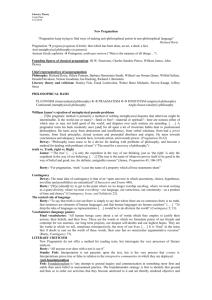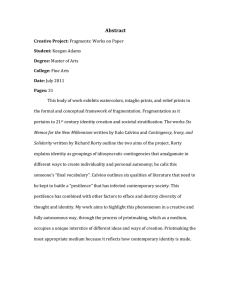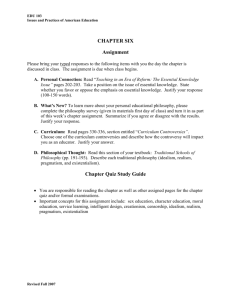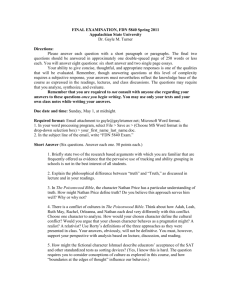Hermeneutics and Pragmatism Endre Begby Simon Fraser University
advertisement
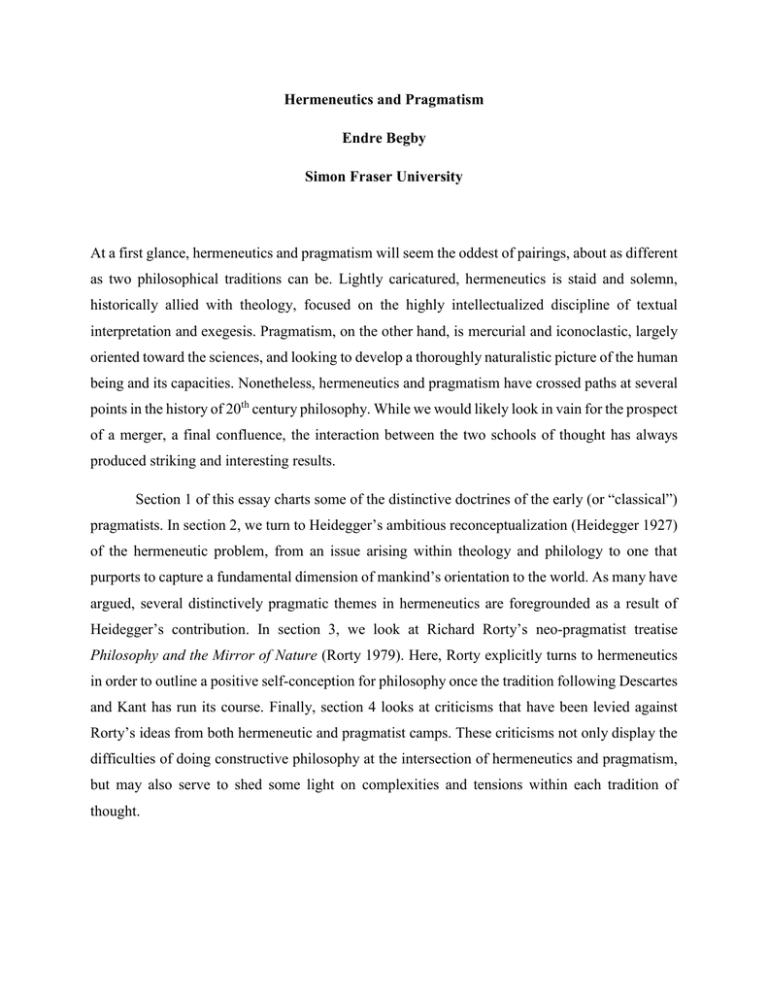
Hermeneutics and Pragmatism Endre Begby Simon Fraser University At a first glance, hermeneutics and pragmatism will seem the oddest of pairings, about as different as two philosophical traditions can be. Lightly caricatured, hermeneutics is staid and solemn, historically allied with theology, focused on the highly intellectualized discipline of textual interpretation and exegesis. Pragmatism, on the other hand, is mercurial and iconoclastic, largely oriented toward the sciences, and looking to develop a thoroughly naturalistic picture of the human being and its capacities. Nonetheless, hermeneutics and pragmatism have crossed paths at several points in the history of 20th century philosophy. While we would likely look in vain for the prospect of a merger, a final confluence, the interaction between the two schools of thought has always produced striking and interesting results. Section 1 of this essay charts some of the distinctive doctrines of the early (or “classical”) pragmatists. In section 2, we turn to Heidegger’s ambitious reconceptualization (Heidegger 1927) of the hermeneutic problem, from an issue arising within theology and philology to one that purports to capture a fundamental dimension of mankind’s orientation to the world. As many have argued, several distinctively pragmatic themes in hermeneutics are foregrounded as a result of Heidegger’s contribution. In section 3, we look at Richard Rorty’s neo-pragmatist treatise Philosophy and the Mirror of Nature (Rorty 1979). Here, Rorty explicitly turns to hermeneutics in order to outline a positive self-conception for philosophy once the tradition following Descartes and Kant has run its course. Finally, section 4 looks at criticisms that have been levied against Rorty’s ideas from both hermeneutic and pragmatist camps. These criticisms not only display the difficulties of doing constructive philosophy at the intersection of hermeneutics and pragmatism, but may also serve to shed some light on complexities and tensions within each tradition of thought. 1. Pragmatism Pragmatism is, in origin and essence, a distinctively American product. It is common to pick out the trio of Charles Sanders Peirce (1839-1914), William James (1842-1910), and John Dewey (1859-1952) as its earliest and most influential expositors. Though quite different in terms of intellectual temperament and philosophical focus, their work overlaps in substantial and interesting ways which allows us to say, at least to a first approximation, what pragmatism as a philosophical orientation is all about. Pragmatism, as a coinage and a rallying-cry, traces back to what is sometimes referred to as Peirce’s “pragmatist maxim,” a methodological precept for philosophical reflection which counsels us to analyze our philosophical concepts and commitments in terms of their “practical bearings” (Peirce 1878: 132). Accordingly, pragmatism was, from its earliest beginnings, driven by the idea that philosophy should focus on the human situation: “Philosophy is a science based upon everyday experience,” wrote Peirce; accordingly, “we must not begin by talking of pure ideas,” but rather with “men and their conversation” (Peirce n.d.: 112). The early pragmatists recognized the tremendous progressive potential of scientific inquiry and argued that we should view philosophy – or at any rate, good philosophy – as fundamentally continuous with science. Thus, the pragmatic maxim joins with the scientific conception of philosophy to produce a robust anti-metaphysical stance: pragmatism, James argued, is a corrective against philosophy’s tendency to get entangled in interminable metaphysical disputes. Unless their resolution can be shown to make some difference to our practical affairs, philosophical questions should simply be cast aside, rather than be honored with reverence and dedicated study. Nonetheless, the pragmatists’ attempt to bring philosophy into register with scientific inquiry at large was never done in a spirit of reductionism. Not only would such reductionism be at odds with the deep-rooted humanism of the pragmatist project. It would also run counter to the grounding spirit of the pragmatist maxim itself: for the point of expanding the domain of scientific inquiry is the practical aim of improving the human condition. By contrast, reductionism is driven by a metaphysical agenda of just the sort that pragmatists abjure, namely that of showing how the ontology of science (or some preferred branch of science) can account for all there is. So on the one hand, it is distinctive of pragmatists that they considered scientific inquiry in the broadest possible sense, and would pay particular attention to the then nascent disciplines of biology and psychology. But they were also explicitly concerned with reconciling “the scientific loyalty to facts” with “the old confidence in human values” (James 1907: 495). Here they drew inspiration from a number of previous efforts, such as David Hume’s A Treatise of Human Nature (1739-40), Auguste Comte’s Course de Philosophie Positive (1832-1840) and John Stuart Mill’s A System of Logic (1843). This foregrounding of practical concerns within philosophy and science can be seen quite clearly in pragmatist epistemology. Most immediately, pragmatist epistemology can be characterized as fallibilist but anti-Cartesian (Hookway 2013). It is fallibilist insofar as it holds that none of our beliefs could ever be immune from the possibility of error, and in particular, that no amount of rational reflection could ever ensure us of its infallibility. Yet their position is antiCartesian in holding that Descartes reasoned illicitly from the fact of human fallibility to the relevance of radical skepticism. On the one hand, Cartesian skepticism presumes the cogency of a subject that is alienated from its environment in a particular way, such that it could even be in the position to deploy its rational capacities at the same time as it casts doubt on all its worldly beliefs. Pragmatists deny that this Cartesian picture of the detached rational cognizer is even cogent. But less obviously, Cartesian skepticism also presumes that we could not be warranted in holding any belief unless we could cite positive evidence in its favor. Instead, pragmatism counsels us to embrace the consequences of fallibilism more fully: inquiry must start in the thick of things, within a concrete context defined by the beliefs and the practical concerns that brought us to where we are. These beliefs can have a positive epistemic status in spite of the fact that they may well be wrong, and in spite of the fact that we are (currently) unable to cite any evidence for them. With their critique of Descartes, pragmatists clearly signaled their allegiance to empiricism. But, their admiration of Hume notwithstanding, it is also important to recognize within their epistemology an important corrective to traditional empiricist thought. Thus, pragmatists were empiricists insofar as they believed that any claim to knowledge must prove its mettle with respect to experience. But simultaneously, they chastised Hume (and other empiricists) for holding on to a narrow and reductionist conception of experience. Traditional empiricists held that knowledge must be traced back to immediate sensory experience. Pragmatists, by contrast, believed there was no such thing as a sensory ‘given.’ On their view, all experience is richly suffused with human conceptualization and shaped by our practical concerns. John Dewey, in particular, denounced what he called the “spectator theory of knowledge,” which he saw as a shared sin of both rationalism and empiricism. Instead, Dewey’s account of experience revolves around the notion of a “situation” arising from “the intercourse of a living being with its physical and social environment” (Dewey 1917: 47). This situational approach thematizes experience in terms of its practical significance first and foremost, leading Dewey to define pragmatism as such in terms of the view that reality itself possesses a “practical character” (Dewey 1908: 126). With their combination of a fallibilist epistemology and an unflinching focus on human concerns, pragmatists were never going to have an easy time with the concept of truth. Pragmatists were united in the negative claim that certain received accounts of truth – such as the notion that truth consists in the “correspondence” between belief and reality – were hopelessly muddled. Nonetheless, the positive accounts of truth on offer in pragmatism can be seen to pull in contrary directions: on the one hand, toward realism, with the belief that truth is transcendent and independent of human concerns, and on the other hand, toward idealism, with the belief that truth is indexed to human belief. This is clearly an uncomfortable position for pragmatists to find themselves in, insofar as the dispute between realism and idealism is precisely the sort of metaphysical baggage that they would have hoped to dispense with. A famous passage from Peirce may be seen to illustrate both tendencies at once. Peirce writes: “the opinion which is fated to be ultimately agreed by all who investigate, is what we mean by truth, and the object represented in this opinion is real” (Peirce 1878: 139). On the one hand, this view seems to flirt with idealism insofar as it makes appeal to agreement among “those who investigate.” But on the other hand, it tries to soften this appeal and pull in the direction of realism by stipulating that we are talking not about what is agreed to now by a specific set of investigators, but rather about what is “fated” to be agreed by all investigators. Thus, Peirce’s view of truth is sometimes also cashed out in terms of what would be believed by an ideal scientific community at the end of inquiry. It is fair to say that Peirce’s account of truth never fully satisfied even his fellow pragmatists. (See, e.g., Misak 2013: 36-37.) By contrast, James’s most famous exposition of the concept of truth draws an analogy with the place of goodness in the ethical realm: truth is simply what is “good in the way of belief” (James 1907: 520). James seems to cash this out in terms of a notion of “instrumental truth,” leaving it open, perhaps, whether there could be any other form. Thus: “any idea that will carry us prosperously from any one part of our experience to any other part, linking things satisfactorily, working securely, saving labor; is true for just so much, true in so far forth, true instrumentally” (James 1907: 512). Dewey’s most notable contribution introduces the notion of “warranted assertibility” (e.g., Dewey 1938), i.e., the question of what justifies our claims to knowledge in a social context. This is surely a question that pragmatists ought to focus on. But it remains controversial whether it could take the place previously assumed by the concept of truth, or whether it simply amounts to letting go of that concept altogether. (On this, see Dewey 1941). At any rate, the question of truth was sharply contested among the early pragmatists, with Peirce, in particular, chiding what he saw as the irrationalist and relativist tendencies of James and Dewey. And as we shall see later, it remains a bone of contention to the present day, with the battle over the legacy of pragmatism largely divided by those who side with Peirce, on the one hand, and those who side with James and Dewey on the other. 2. Heidegger’s hermeneutics Throughout most of its history, hermeneutics had been devoted to the study of textual interpretation – paradigmatically, scriptural interpretation. Even though hermeneutics would seek to apply itself more broadly as philology gained a foothold in various academic disciplines, it would remain, within the context of German philosophy at large, but an eddy within the larger streams of thought following from Kant and Hegel. But there were signs indicating that a more fundamental shift of perspective was coming on: among the trailblazers were Schleiermacher, who championed a view of hermeneutics as dealing with all linguistically mediated understanding, not just with textual interpretation, and Dilthey, who advocated hermeneutics as the canonical method for the human sciences as such. Martin Heidegger would build on these developments, radicalizing them even further. On his development, “hermeneutics” comes to denote, first and foremost, not an epistemological method or procedure that individuals can apply to come to grips with a particular problem, as would still appear to be the case with Schleiermacher and Dilthey. Rather, with Heidegger hermeneutics takes an ontological turn, aiming to reveal the fundamental structure of Dasein’s being-in-the-world. Heidegger’s Being and Time (1927), in particular, is a work that resonates deeply with pragmatist themes, even though it is cast in a terminology and style of argumentation that would have been quite unfamiliar to the early pragmatists. We can only speculate whether this is an instance of actual influence or just happy convergence: it is likely that Heidegger would at least have been exposed to American pragmatism through his teacher Emil Lask, who was a well-known early exponent of pragmatism in German academia. (See Dreyfus (1990: 6), Kisiel 1995: 25-28, Joas 1993: 105-106.) And over the last decades, there has emerged an impressive body of work reading Heidegger in a way that puts his thinking into register with themes in American philosophy in general, and with pragmatic themes in American philosophy in particular (e.g., Okrent 1988, Dreyfus 1990, Blattner 1992, Carman 2003, Wrathall 2010, Haugeland 2013). Heidegger remained deeply skeptical of pragmatism’s infatuation with science, and specifically with the idea that science holds the key to social progress. Nonetheless, he is in deep agreement with the pragmatists’ view that mankind’s orientation to the world is engaged and practical first and foremost, and only derivatively detached and theoretical. There is nothing wrong or disingenuous about the theoretical stance as such: on its own terms, it is an important and entirely valid stance. But philosophy loses track of itself and the human condition when this stance is elevated and seen as fundamental in the way that it is, for instance, in Cartesian epistemology. Cartesian epistemology invites us to think of a detached and perhaps even disembodied cognitive subject which is faced with the task of building up its relation to the world piece by piece by way of intellectual operations. Heidegger believes, very much in line with the pragmatist critique above, that this picture entirely distorts our situation. The world is not given to us as a collection of facts or entities whose nature and interconnections it is our task to sort out. (See, e.g., Ramberg and Gjesdal 2005). Instead, our way of inhabiting our world is characterized by what Heidegger terms “understanding” (Verstehen) (see e.g., Heidegger 1927: ch. 5). In using this term, Heidegger certainly means to connect his inquiry with the hermeneutics of Schleiermacher and Dilthey. But his deployment of the term also suggests the point at which he breaks with his predecessors. For in traditional hermeneutics, understanding is precisely thought of in epistemological terms, as the concerted effort to overcome an initial state of confusion and bewilderment so as to make sense of the text or phenomenon that confronts us. On Heidegger’s deployment of the term, to the contrary, “understanding” bespeaks familiarity rather than estrangement and denotes our pre-reflective way of inhabiting the world. Understanding, then, is not best thought of as something that we can seek, cultivate, be better or worse at, as traditional hermeneutics would have it. Rather, it is the fundamental and distinctive aspect of our being-inthe-world. It is this form of familiarity which in turn makes possible the more distanced, empirical, objectivizing modes of knowledge that are characteristic of the sciences and other forms of methodical inquiry. With this emphasis on the practical orientation over the detached observer perspective, Heidegger’s ontological turn in hermeneutics displays a clear affinity with themes from pragmatism. But it is not just the anti-Cartesian stance that suggests interesting overlaps with pragmatism. Like the pragmatists, Heidegger asserts that inquiry – even the more refined inquiries of natural science – must start in the middle of things, with our day-to-day routines and purposes. Moreover, inquiry cannot confront facts and objects one by one, but always operates within a given structure of significance, “a relational whole” (Bewandtnisganzheit) (see, e.g., Heidegger 1927: chs. 15, 18). Perhaps the clearest illustration of this pragmatic strand in Heidegger’s thinking comes in the form of his famous notion of the “ready-to-hand” (Zuhandenheit) (Heidegger 1927: chs. 15-16). Ready-to-handness is the property that objects have insofar as we engage them in an immediate and unreflective manner in order to carry out our everyday projects. Heidegger draws an analogy with tools to illustrate this property: our way of engaging with, say, a hammer, is not qua inert object. Rather, we use it, and are scarcely more aware of it qua object than we are of our own bodily appendages. It is only when the tool breaks or otherwise fails to serve its purpose that explicit attention is brought to it as such. This mode of ready-to-handness is to be contrasted with that of the present-to-hand (Vorhandenheit), where things are encountered simply or primarily as objects of observation and inquiry, as it is in science. Of the early pragmatists, it is perhaps Dewey, with his explicit emphasis on the distinction between propositional and practical knowledge, and with his assertion that reality itself has a “practical structure” which is closest in spirit to Heidegger’s hermeneutic program in Being and Time. 3. Rorty and the resurgence of pragmatism By the 1930s, the influence of pragmatism on American philosophy was on the wane, as logical positivism came to prominence, aided by the influx of émigré scholars such as Rudolf Carnap, Hans Reichenbach, and Carl Gustav Hempel. Logical positivism was a school of comparable sweep and ambition to pragmatism, and similarly committed to a naturalistic and scientific conception of philosophy. But it was driven by a much more rigorous methodological program, and had little patience with pragmatism’s pluralism and anti-reductionism. Even though it is common – in retrospect – to recognize distinctive pragmatist themes in many of the leading American analytic philosophers during the period, such as W.v.O Quine, Wilfrid Sellars, and Nelson Goodman, there can be little doubt that pragmatism was effectively marginalized in the decades flanking World War II. If any one person is to be credited with the resurgence of interest in pragmatism, it is arguably Richard Rorty. Though immersed in contemporary analytic philosophy, Rorty was deeply dissatisfied with the direction it had taken, and turned to pragmatism to frame his critique. Much of his 1979 book Philosophy and the Mirror of Nature, while extremely polemical, nonetheless follows along relatively familiar pragmatist tracks. What might have seemed more surprising – certainly so to his contemporaries – was the fact that Rorty also explicitly and self-consciously turned to hermeneutics to frame both the critical and the constructive aspects of his work. While Heidegger was certainly instrumental to Rorty’s turn toward hermeneutics (see e.g., Rorty 1976), it is the work of Heidegger’s student Hans-Georg Gadamer which provides the scaffolding for the final and perhaps most important part of Philosophy and the Mirror of Nature. While deeply inspired by Heidegger’s ontological turn in hermeneutics, Gadamer’s magnum opus Truth and Method (Gadamer 1960) has none of the self-conscious revolutionary zeal that marks out Heidegger’s work. Instead, Gadamer’s work constitutes a subtle and careful rumination on the quest for knowledge in the human sciences. Among its central ideas is the positive epistemic significance of prejudice (Vorurteile) and the indispensable role played by tradition in mediating truth and knowledge. One may certainly wonder what appeal a work building on such premises might have held to a self-styled pragmatist renegade such as Richard Rorty. Rorty’s appropriation of Gadamer is certainly tendentious and agenda-driven. But at the same time, it does pick up an important strand in Gadamer’s work. As noted above, Rorty’s primary engagement with Gadamer takes place in the third and final section of his book, in which philosophy itself becomes the subject matter of critical reflection. The overarching aim of the book is to throw critical light on a certain conception of the task of philosophy, especially entrenched since Descartes and Kant, according to which philosophy stands as the adjudicator of knowledgeclaims in the various disciplines of inquiry, a role that it can claim in virtue of its “special understanding of the nature of knowledge and of mind” (Rorty 1979: 3). In order to unmask the conceit behind this self-conception, Rorty aims to “historicize” a selection of central and distinctive philosophical problems, with the aim of showing that they are not the “perennial problems” that philosophy likes to claim as its own, and on whose solution would hang insights into the deepest structures of reality and the human mind. Instead, they are historically transient problems – pseudo-problems, even – that arise as a consequence of philosophy coming to take up specific conceptual tools and vocabularies at specific times. These problems will not be solved, so much as simply abandoned whenever philosophy reaches its next conceptual crossroads. Here, Rorty was clearly drawing inspiration from Kuhn’s account of scientific progress as occurring by way of wholesale switches from one theoretical paradigm to another, where each paradigm sets its own agenda for what are the problems worth solving (Kuhn 1962). (Kuhn himself would occasionally invoke hermeneutics to describe an important dimension of his account (see, e.g., Kuhn 1977: xv.) Accordingly, the first two parts of Rorty’s book apply this procedure, respectively, to the problem of mind and body and to the problem of epistemology. The third and final part of the book looks to philosophy itself. And here is where Gadamer’s work becomes central to Rorty’s thinking. The final part of Rorty’s work is entitled “From Epistemology to Hermeneutics.” Rorty wants to make clear from the outset, however, that hermeneutics is not being put forward as a “successor subject” to epistemology, some alternative agenda for pursuing the theory of knowledge. Instead, Rorty claims to use “hermeneutics” as a “polemical term” (Rorty 1979: 357) in particular, as “an expression of hope that the cultural space left by the demise of epistemology will not be filled” (Rorty 1979: 315). On Rorty’s analysis, traditional epistemology proceeds on the assumption that all contributions to discourse – all knowledge-claims – are “commensurable” (borrowing terminology from Kuhn), such that disputes can be brought under a single set of rules – a decision procedure – which would allow us, at least in principle, to adjudicate which claim is right. According to the tradition from Descartes and Kant, it is the job of philosophy to clarify these rules and to serve as custodians of the decision procedure. Rorty believes there can be no such rules, and accordingly, that philosophy’s selfconception rests on a mirage. As a counterpoint, Rorty draws on Gadamer’s idea that knowledgeseeking should be thought of in terms of a conversation in which different points of view are expressed, and through which, when all goes well, we may hope to transcend the cognitive limitations of either of the original contributions (what Gadamer (1960: 305) called a “fusion of horizons”). But as we embrace this picture, we also come to realize that this moment of transcendence is not a resting point in which we can claim final knowledge. Rather, it is simply the starting point for yet more conversation. Moreover, on this dialogical picture of knowledgeseeking, there is no way to disentangle the “substantive” points of agreement and disagreement from those that concern the question of how disagreements should be resolved. These matters are inextricably linked, and both under scrutiny. Instead of Knowledge (with a capital K, as conceived of in traditional epistemology), Rorty argues that philosophers should seek to cultivate what Gadamer (e.g., 1960: 8-16) calls Bildung (roughly, learning or edification). Unlike Knowledge, Bildung does not imply a final product, but rather a personal attitude: rather than despair of the loss of a single all-encompassing decision procedure for adjudicating knowledge-claims, a person possessing Bildung will cultivate an openness to new and enriching experiences, constantly seeking to integrate a diversity of perspectives. Thus, Rorty turns to hermeneutics, in no small part, for therapeutic counsel: to adjust ourselves to this post-epistemological conception of philosophy is for us to come to terms with the fact that our knowledge-seeking practices can never finally transcend the limitations of the human situation. Even though we may never find a decision procedure that will enforce agreement among all rational parties (or else allow us to dismiss as irrational those who do not agree), Gadamer’s dialogical model of understanding reminds us that “the hope of agreement is never lost so long as the conversation lasts” (Rorty 1979: 318). But Rorty is clear that conversational agreement is no substitute for truth. Just as hermeneutics is not the name of a successor discipline to epistemology, so Rorty’s focus on agreement is not tantamount to putting forward a “consensus theory of truth” to substitute for traditional epistemology’s correspondence theory. Rorty’s pragmatism makes no claim that truth and agreement are conceptually connected. Nonetheless, the focus on agreement is a good thing, in that it serves to remind us that insofar as our pursuit of knowledge is governed by norms – knowledge claims must, after all, be backed by justification –, the norms in question pertain primarily to our relationship to our fellow human beings, not to the relation between the individual inquirer and the world. Nonetheless, it is important to note that Rorty’s appropriation of hermeneutics is not without critical intent. Many leading hermeneuticists – Heidegger and Gadamer not least – display strong anti-scientistic tendencies, and they seek to entrench their anti-scientism in the form of a firm and principled distinction between two domains of inquiry: one the one hand, that which concerns human beings and their situation, and, on the other hand, that which concerns the rest of the physical universe. The truths of hermeneutics, then, are meant in part to serve as a bulwark against the intrusion of natural scientific modes of inquiry on the human domain. On Rorty’s pragmatist approach, this distinction can only be provisional: hermeneutics is guilty of fashioning metaphysics from conceptual baggage which may be unceremoniously abandoned at the next crossroads in science or philosophy. Rorty does not mean to dispute the distinction between the natural and the human sciences within our current scheme of inquiry. The distinction is real, but its significance may have nothing to do with its tracing a fundamental cleavage in the fabric of the universe. On Rorty’s view, the virtue of Bildung described above requires precisely that we remain open to the possibility that such a distinction – fundamental though it may seem to us now – may simply reflect a hang-up in our current way of thinking. 4. Reactions to Rorty If Rorty’s book was meant to provoke, it was an immediate success. Philosophy and the Mirror of Nature would quickly garner scorching criticism from virtually all quarters of philosophy. One persistent and vocal critic has been Susan Haack, who argues that Rorty’s attempt to reroute the course of contemporary philosophy “masks a cynicism which would undermine not only epistemology, not only ‘systematic’ philosophy, but inquiry generally” (Haack 1993: 182-3). Haack’s challenge is important in its own right, but is doubly noteworthy for the fact that it also concerns Rorty’s appropriation of the label ‘pragmatism.’ She derides Rorty’s appropriation as “vulgar pragmatism,” one that steals the name but shamelessly abandons the constructive project that once animated it. Similar thoughts are echoed by Nicholas Rescher (e.g., Rescher 2000) and, most recently, by Cheryl Misak in her important book The American Pragmatists (Misak 2013). In an important sense, though, Rorty is not the sole target of criticism here. Rorty was always explicit that his pragmatism is that of James and Dewey, not that of Peirce (see, e.g., Rorty 1993). And what unites these critics is precisely a deep admiration of Peirce, and a sense that the history of pragmatism is one of decline ever since. To this extent, the controversy over Rorty’s neo-pragmatism bears testimony to deep tensions within pragmatism itself. As we saw above, the crux of the rift between Peirce and subsequent pragmatists was precisely the concept of truth (and cognate concepts such as evidence, justification, and objectivity). What would be vulgar about Rorty’s pragmatism is simply his self-conscious abandonment of any vestige of the Peircean heritage, and in particular, the abandonment of any substantive account of the role of truth in guiding inquiry. From the standpoint of this criticism, it is tempting to think that Rorty’s flirtation with hermeneutics and other forms of “continental philosophy” is just another symptom of his reckless disregard for truth. Accordingly, it is important to note that similar concerns have also been voiced by hermeneuticists protesting against Rorty’s appropriation of Gadamer. Thus, for instance, Charles Guignon (1982: 366), Georgia Warnke (1987: ch. 5), and Brice Wachterhauser (1994) all argue that Rorty’s appropriation of hermeneutics misses the central role of truth in Gadamer’s work. Even though Gadamer insists that no cognitive procedure would ever allow us to finally transcend our historical finitude, he remains firm in his conviction that it is truth which comes to light through these conversational encounters. In Wachterhauser’s words: “Only by seeing our conversation as ultimately governed by the norm of truth do our many attempts to make a point in a conversation become something more than the utterance of a series of sounds which we hope will effect the behavior of our interlocutor for our own advantage. Only the sincere search for truth adequately distinguishes rational inquiry from mere sophistry” (Wachterhauser 1994: 3). This suggests, interestingly enough, a second and very different perspective on the convergence between hermeneutics and pragmatism, namely a convergence in resistance to Rorty’s disregard for the concept of truth. From this perspective, Rorty emerges as a vulgarizer of hermeneutics no less than of pragmatism: one who coopts the surface rhetoric, while letting go of the subtler ideas lying underneath. This is certainly not a trifling matter. But Rorty’s challenge remains: how might one connect, in a useful and substantive way, this notion of truth with a notion of inquiry strongly centered, as both pragmatism and hermeneutics is, on the human situation? It is one thing to assert that without appeal to the concept of truth, our conversational interactions will reduce to manipulation and inquiry will grind to a halt. It is quite another thing to say, in concrete practical terms, what the invocation of truth contributes above and beyond that of being justified in the eyes of one’s peers. On Rorty’s view, once one has come properly to terms with fallibilism and with the irreducibly social character of epistemic justification, then invoking the concept of truth does nothing more than pander to vestigial philosophical scruples which should be ruthlessly abandoned rather than indulged. 5013 words. References: Blattner, W.D. (1992) “Existential Temporality in Being and Time (Why Heidegger is not a Pragmatist),” in H.L. Drefyus and H. Hall (eds.), Heidegger: A Critical Reader, Oxford: Blackwell, pp. 99-129. Carman, T. (2003) Heidegger’s Analytic: Interpretation, Discourse and Authenticity in Being and Time, Cambridge University Press. Dewey, J. (1908) “Does Reality Possess Practical Character?” reprinted in L.M. Hickman and T.M. Alexander (eds.), The Essential Dewey, Vol. 1, Bloomington, IN: Indiana University Press, 1998, pp. 124-133. ----- (1917) “The Need for a Recovery of Philosophy,” reprinted in L.M. Hickman and T.M. Alexander (eds.), The Essential Dewey, Vol. 1, Bloomington, IN: Indiana University Press, 1998, pp. 46-70. ----- (1938) Logic: The Theory of Inquiry, New York: Henry Holt and Co. ----- (1941) “Propositions, Warranted Assertibility, and Truth,” in The Journal of Philosophy 38 (7), pp. 169-186. Dreyfus, H.L. (1990) Being-in-the-World: A Commentary on Heidegger's Being and Time, Division I, Cambridge, MA: The MIT Press. Gadamer, H.G. (1960) Truth and Method, translated by J. Weinsheimer and D.G. Marshall, London: Continuum Publishing, 1989. Guignon, C.B. (1982) “Saving the Differences: Gadamer and Rorty,” in PSA: Proceedings of the Biennial Meeting of the Philosophy of Science Association, pp. 360-367 Haack, S. (1993) Evidence and Inquiry: Towards Reconstruction in Rpistemology, Oxford: Blackwell. Haugeland, J. (2013) Dasein Disclosed: John Haugeland’s Heidegger, edited by Joseph Rouse, Cambridge, MA: Harvard University Press. Heidegger, M. (1927) Being and Time, translated by J. Stambaugh, Albany, NY: SUNY Press, 1996. Hookway, C. (2013) “Pragmatism,” in E. Zalta (ed.), The Stanford Encyclopedia of Philosophy (Winter 2013 Edition), Stanford, CA: CSLI Publications. James, W. (1907) Pragmatism: A New Name for Some Old Ways of Thinking, reprinted in Writings 1902-1910, New York: Library of America, pp. 479-624. Joas, H. (1993) Pragmatism and Social Theory, Chicago, IL: University of Chicago Press. Kisiel, T.J. (1995) The Genesis of Heidegger's “Being and Time,” Berkeley, CA: University of California Press. Kuhn, T.S. (1962) The Structure of Scientific Revolutions, Chicago, IL: University of Chicago press. Kuhn, T.S. (1977) The Essential Tension. Selected Studies in Scientific Tradition and Change, Chicago, IL: University of Chicago Press. Misak, C. (2013) The American Pragmatists, Oxford University Press. Okrent, M. (1988) Heidegger’s Pragmatism: Understanding, Being, and the Critique of Metaphysics, Ithaca, NY: Cornell University Press. Peirce, C.S. (1878) “How to Make Our Ideas Clear,” reprinted in N. Hauser and C. Kloesel (eds.), The Essential Peirce: Selected Philosophical Writings, Vol 1, Bloomington, IN: Indiana University Press, 1992, pp. 124-141. -----. (n.d) “Review of Josiah Royce, The World and the Individual,” reprinted in A.W. Burks (ed.), The Collected Papers of Charles Sanders Peirce, Vol. VIII, Cambridge, MA: Harvard University Press, 1958, pp. 100-131. Ramberg, B. and Gjesdal, K. (2005) “Hermeneutics,” in E. Zalta (ed.), The Stanford Encyclopedia of Philosophy (Winter 2005 Edition). Rescher, N. (2000) Realistic Pragmatism: An Introduction to Pragmatic Philosophy, Albany, NY: SUNY Press. Rorty, R. (1976) “Overcoming the Tradition: Heidegger and Dewey,” in The Review of Metaphysics 30 (2), pp. 280-305. Rorty, R. (1979) Philosophy and the Mirror of Nature, Princeton, NJ: Princeton University Press. Rorty, R. (1993) “Hilary Putnam and the Relativist Menace,” in The Journal of Philosophy 90 (9), pp. 443-461. Wachterhauser, B.R. (1994) “Introduction: Is there Truth after Interpretation?” in B.R. Wachterhauser (ed.), Hermeneutics and Truth, Evanston, IL: Northwestern University Press, pp. 1-23. Warnke, G. (1987) Gadamer: Hermeneutics, Tradition, and Reason, Palo Alto, CA: Stanford University Press. Wrathall, M.A. (2011) Heidegger and Unconcealment: Truth, Language, and History, Cambridge University Press. About the author: Endre Begby (PhD., University of Pittsburgh) is Assistant Professor of Philosophy at Simon Fraser University. His publications include articles in Journal of Philosophy, Philosophical Studies, Politics, Philosophy Compass, and Thought, as well as a major anthology, The Ethics of War: Classic and Contemporary Readings (with Gregory Reichberg and Henrik Syse; Blackwell 2006).
